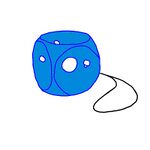Vaginal Flatulence
Definition[edit | edit source]
It is the discharge of gas, air, or wind which is audible and sensible, from the vagina due to a change in position or posture (often seen during coitus, stretching, or performing exercises). The gas passed is odorless and harmless by nature but may cause embarrassment to the person experiencing it(generally in front of a partner during or immediately after coitus) and stress in some individuals.[1][2]
Most women do not seek medical help due to the embarrassing nature of this condition[3] and therefore this condition is scarcely reported by them.[4]This condition majorly affects the Quality of life as it results in shame, sexual dysfunction(in severe cases), and even social isolation(in severe cases).[2]
Nomenclature[edit | edit source]
Commonly used slang-
- Queef/Queefing- It is the most popular term used in social media, especially by famous sex educators on Instagram, Facebook, etc., and also in magazines. This term is also quite popular in pornography.
- Vart
- Fanny Fart
In medical literature, it has been defined by several other names -
- Vaginal wind
- Vaginal gas
- Vaginal noise
- Vaginal flatus
- Flatus vaginalis
- Incontinentia vulvae
- GARRULITAS VULVAE- The very first scientific term used by J.A.F. Attapattu in 1995 to describe vaginal flatulence.[5]
- Chattering Vulva
- Vaginal Flatulence
Prevalence[edit | edit source]
Vaginal flatus is prevalent in women with pelvic floor disorders, particularly in those who are younger and sexually active.[4]
In a research done by Marijke et al. roughly one out of eight women in the general population(45-85 years of age) was suffering from the condition.[6]
Vaginal flatus was prevalent in 20% of participants, as shown by a research done on Iranian women in 2012.[7]
Symptoms[edit | edit source]
- Often occurs on random movements.
- Frequency- a few times a week or multiple times a day.
- Sucking of water in the vagina during the bath further results in an involuntary flow of water out of the vagina after leaving the bath.[3][2]
- Very weak noise.
- Presence of other pelvic floor dysfunctions. (may or may not be)
Causes/Factors[edit | edit source]
Provoking factors[edit | edit source]
- Coitus (mostly during doggy style)[8]
- Change of posture/position
- Increased abdominal pressure
- Digital stimulation
- Cunnilingus
- Lubrication
- Any previous surgery
- Exercise
- Jogging
- Vaginal Estrogenization[9] [2][10]
Risk factors[edit | edit source]
- Pelvic floor dysfunction- Anal incontinence, Prolapse, anterior and posterior vaginal wall prolapse, Urinary stress incontinence, Pelvic Organ Prolapse
- Vaginal Surgery-hysterectomy, pelvic floor reconstruction. [2][10]
- Inflammatory Bowel disease
- Radiation therapy
- Enterovaginal fistula
- [3]Tumor
- Low BMI[7]
Protective factors[edit | edit source]
Quality Of Life[edit | edit source]
The literature till now has concluded that there is a major impact on the quality of life of the patient mostly being psychological. It can cause distress, lack of confidence, reduced social isolation, and embarrassment. It is taboo to talk about this subject which might cause further stress. It might not be a fatal or a risky problem in general but can be bothersome in daily life. There is also decreased sexual satisfaction seen in the individual if the problem prevails.[2]It has been reported it can even cause distress in women while performing religious prayers. [7]
Pathophysiology/Mechanism[edit | edit source]
In literature, the mechanism or pathology of this condition has been inconclusive. However, there are some theories given by the researchers regarding the process of trapping air, the expulsion of wind, and audible noise.
- There is air in the vagina that is normally present due to the fact that the vaginal anterior and posterior walls are elastic and closely adjacent. Due to tumors or any other non-tumoral factors, there may be the creation of large air bubbles causing rigidity and loss of elasticity of the walls of the vagina. Hence there is intravaginal trapping of air.[11]
- It occurs as a natural phenomenon. The air is forced inside the vaginal canal and expelled due to the contraction of the muscles of the canal.[1]
- It happens in the presence of risk factors. The air enters the vaginal introitus in certain positions and ejects on a change of posture.[5]
- The vaginal wind is created due to valve-like structures at the opening of the vagina creating a potential space in the canal. When the person is at rest, air enters freely into the cavity but it closes with movement and thus air gets trapped in the vagina. On activity, as the abdominal and pelvic pressure increases air is thrown out through a then narrowed and closed introitus producing a noise (which is similar to escaping of air through a musical air instrument and then producing sound).[3]
- There is a possibility of air in the vagina being trapped and expelled due to the vibration in the walls of the vagina at the level of its opening.[9]
- It is possible due to low body mass index, the vaginal wall is inadequately supported to prevent the walls from folding over each other.[7]
- There are certain positions that are held during cunnilingus and digital stimulation in which the tone of the muscles of the pelvic floor and intraabdominal pressure change, causing air to sneak inside the vagina canal. [2]
Treatment[edit | edit source]
Conservative /Physiotherapy Treatment[edit | edit source]
- Yoga- Performing some breathing and relaxation exercises can reduce stress and tension.
- Kegel exercises
- A vaginal pessary- Is inserted in the vaginal canal to prevent the trapping of air inside.
- Bard pessary[3]- another type of pessary inserted in the canal to prevent air from being trapped.
- Pelvic floor muscle training
- Tampon [2]
- Rounded pessary [12]
- Radiofrequency and Vaginal lasers[8]
Non-conservative treatment[edit | edit source]
In severe cases, the ones associated with pelvic floor dysfunctions and tumors -surgery is advised
- Anterior and posterior colpoperineorraphy
- Cervix amputation
- Vaginal hysterectomy
- Sacrospinal vaginal fixation [2]
The Role of Physiotherapy[edit | edit source]
Therapists have been using pelvic floor rehabilitation programs to treat patients of flatus. However, the current medical literature does not support Physiotherapy Treatment at present.[3][8]Use of pessaries to solve the problem has been recommended by current evidence. [13]Since there is a lack of literature we require more research and studies to establish the effect of Physiotherapy and other treatment protocols on Vaginal Flatulence.
Conclusion[edit | edit source]
Treatment might not be a necessary option as it is a naturally occurring phenomenon, but counselling is advised if the condition makes one stressed and anxious. This condition can only become risky and one needs to get it treated when there are any other associated conditions involved for example any other pelvic floor dysfunctions or any tumor.
There is also a requirement for further research on this topic as the literature available is scarce.
References[edit | edit source]
- ↑ 1.0 1.1 Allahdin S. Flatus vaginalis a distressing symptom. International journal of colorectal disease. 2011 Nov;26(11):1493-.
- ↑ 2.0 2.1 2.2 2.3 2.4 2.5 2.6 2.7 2.8 2.9 Neels H, Mortiers X, de Graaf S, Tjalma WA, De Wachter S, Vermandel A. Vaginal wind: A literature review. European Journal of Obstetrics & Gynecology and Reproductive Biology. 2017 Jul 1;214:97-103.
- ↑ 3.0 3.1 3.2 3.3 3.4 3.5 Krissi H, Medina C, Stanton SL. Vaginal wind–a new pelvic symptom. International Urogynecology Journal. 2003 Dec;14(6):399-402.
- ↑ 4.0 4.1 Lau HH, Su TH, Chen YY, Huang WC. The Prevalence of Vaginal Flatus in Women With Pelvic Floor Disorders and Its Impact on Sexual Function. The Journal of Sexual Medicine. 2021 Mar 1;18(3):487-92.
- ↑ 5.0 5.1 Attapattu JA. Garrulitas vulvae. A report of six cases. The Journal of reproductive medicine. 1995 Mar 1;40(3):235-6.
- ↑ Pool-Goudzwaard AL, Eijkemans MJ, Steegers-Theunissen RP, Burger CW, Vierhout ME. Vaginal noise: prevalence, bother and risk factors in a general female population aged 45–85 years. International Urogynecology Journal. 2009 Aug;20(8):905-11.
- ↑ 7.0 7.1 7.2 7.3 Veisi F, Rezavand N, Zangeneh M, Malekkhosravi S, Rezaei M. Vaginal flatus and the associated risk factors in Iranian women: a main research article. International Scholarly Research Notices. 2012;2012.
- ↑ 8.0 8.1 8.2 Amarenco G, Turmel N, Chesnel C, Mezzadri M, Le Breton F, Charlanes A, Hentzen C. Vaginal gas: Review. Progres en Urologie: Journal de L'association Francaise D'urologie et de la Societe Francaise D'urologie. 2019 Nov 20;29(17):1035-40.
- ↑ 9.0 9.1 9.2 Miranne JM, Marek TM, Mete M, Iglesia CB. Prevalence and resolution of auditory passage of vaginal air in women with pelvic floor disorders. Obstetrics & Gynecology. 2015 Jul 1;126(1):136-43.
- ↑ 10.0 10.1 Neels H, Pacquée S, Shek KL, Gillor M, Caudwell-Hall J, Dietz HP. Is vaginal flatus related to pelvic floor functional anatomy?. International Urogynecology Journal. 2020 Dec;31(12):2551-5.
- ↑ Hadar H, Kornreich L, Heifetz M, Herskovitz P, Horev G. Air in vagina: indicator of intrapelvic pathology on CT. Acta Radiologica. 1991 Mar;32(2):170-3.
- ↑ Renckens CN, Klinkert J. Garrulitas vulvae: a case refractory to repeated attempts at surgical correction, solved by a novel treatment. European Journal of Obstetrics, Gynecology, and Reproductive Biology. 2012 Jul 21;165(1):129-30.
- ↑ Sahar T, Fatemeh M, Parvin B, Reza SM. The Comparison of the Effects of Pessary, Pelvic Floor Physiotherapy, and Corrective Surgery Methods in Correction of Vaginal Sound in Patients with Pelvic Floor Disorders.











